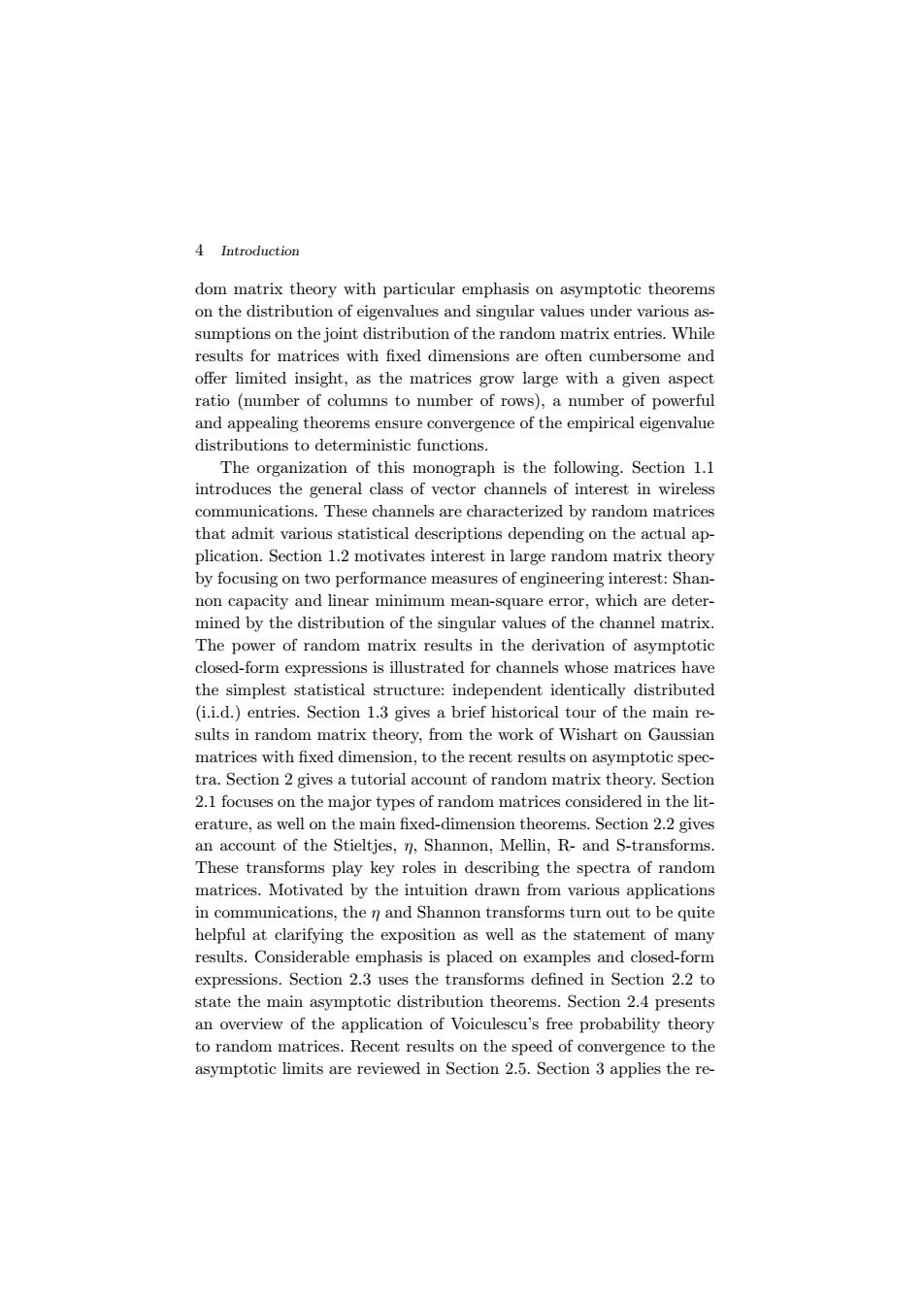正在加载图片...

4 Introduction dom matrix theory with particular emphasis on asymptotic theorems on the distribution of eigenvalues and singular values under various as- sumptions on the joint distribution of the random matrix entries.While results for matrices with fixed dimensions are often cumbersome and offer limited insight,as the matrices grow large with a given aspect ratio (number of columns to number of rows),a number of powerful and appealing theorems ensure convergence of the empirical eigenvalue distributions to deterministic functions. The organization of this monograph is the following.Section 1.1 introduces the general class of vector channels of interest in wireless communications.These channels are characterized by random matrices that admit various statistical descriptions depending on the actual ap- plication.Section 1.2 motivates interest in large random matrix theory by focusing on two performance measures of engineering interest:Shan- non capacity and linear minimum mean-square error,which are deter- mined by the distribution of the singular values of the channel matrix. The power of random matrix results in the derivation of asymptotic closed-form expressions is illustrated for channels whose matrices have the simplest statistical structure:independent identically distributed (i.i.d.)entries.Section 1.3 gives a brief historical tour of the main re- sults in random matrix theory,from the work of Wishart on Gaussian matrices with fixed dimension,to the recent results on asymptotic spec- tra.Section 2 gives a tutorial account of random matrix theory.Section 2.1 focuses on the major types of random matrices considered in the lit- erature,as well on the main fixed-dimension theorems.Section 2.2 gives an account of the Stieltjes,n,Shannon,Mellin,R-and S-transforms These transforms play key roles in describing the spectra of random matrices.Motivated by the intuition drawn from various applications in communications,the n and Shannon transforms turn out to be quite helpful at clarifying the exposition as well as the statement of many results.Considerable emphasis is placed on examples and closed-form expressions.Section 2.3 uses the transforms defined in Section 2.2 to state the main asymptotic distribution theorems.Section 2.4 presents an overview of the application of Voiculescu's free probability theory to random matrices.Recent results on the speed of convergence to the asymptotic limits are reviewed in Section 2.5.Section 3 applies the re-4 Introduction dom matrix theory with particular emphasis on asymptotic theorems on the distribution of eigenvalues and singular values under various assumptions on the joint distribution of the random matrix entries. While results for matrices with fixed dimensions are often cumbersome and offer limited insight, as the matrices grow large with a given aspect ratio (number of columns to number of rows), a number of powerful and appealing theorems ensure convergence of the empirical eigenvalue distributions to deterministic functions. The organization of this monograph is the following. Section 1.1 introduces the general class of vector channels of interest in wireless communications. These channels are characterized by random matrices that admit various statistical descriptions depending on the actual application. Section 1.2 motivates interest in large random matrix theory by focusing on two performance measures of engineering interest: Shannon capacity and linear minimum mean-square error, which are determined by the distribution of the singular values of the channel matrix. The power of random matrix results in the derivation of asymptotic closed-form expressions is illustrated for channels whose matrices have the simplest statistical structure: independent identically distributed (i.i.d.) entries. Section 1.3 gives a brief historical tour of the main results in random matrix theory, from the work of Wishart on Gaussian matrices with fixed dimension, to the recent results on asymptotic spectra. Section 2 gives a tutorial account of random matrix theory. Section 2.1 focuses on the major types of random matrices considered in the literature, as well on the main fixed-dimension theorems. Section 2.2 gives an account of the Stieltjes, η, Shannon, Mellin, R- and S-transforms. These transforms play key roles in describing the spectra of random matrices. Motivated by the intuition drawn from various applications in communications, the η and Shannon transforms turn out to be quite helpful at clarifying the exposition as well as the statement of many results. Considerable emphasis is placed on examples and closed-form expressions. Section 2.3 uses the transforms defined in Section 2.2 to state the main asymptotic distribution theorems. Section 2.4 presents an overview of the application of Voiculescu’s free probability theory to random matrices. Recent results on the speed of convergence to the asymptotic limits are reviewed in Section 2.5. Section 3 applies the re-